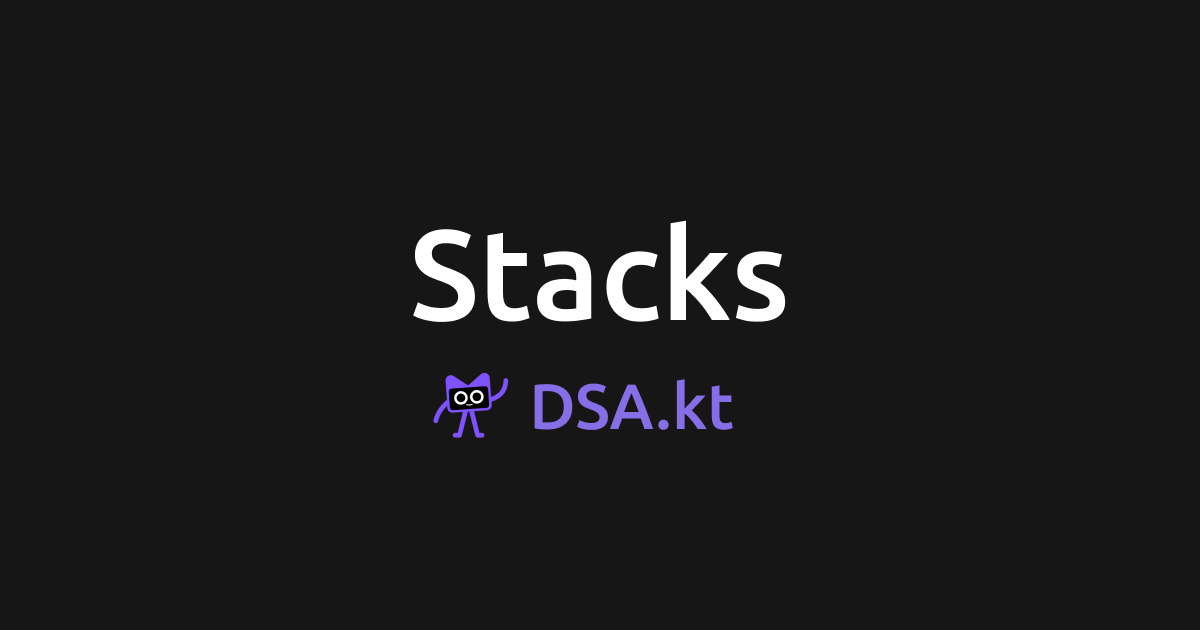Stacks in Kotlin

1. Introduction
Stacks are a fundamental data structure in computer science, characterized by their LIFO (Last-In, First-Out) behavior. This means that the last element added to the stack is the first one to be removed. Stacks are widely used in various computational tasks, including function call management, expression evaluation, and backtracking algorithms.
In Kotlin, stacks can be implemented using collections such as ArrayDeque or LinkedList. While Kotlin doesn’t provide a dedicated Stack class, these collections offer all the methods needed to simulate stack behavior efficiently.
2. Overview of Stacks
Definition and Purpose
A stack is a collection designed to add and remove elements in reverse order of their addition. Stacks are used extensively in scenarios where the order of processing needs to be reversed.
Key Characteristics
- LIFO Order: Elements are processed in reverse order of their addition.
- Dynamic Sizing: Stacks dynamically adjust their size to accommodate elements.
- Efficient Operations: Kotlin’s collections provide optimized methods for pushing and popping elements.
Common Scenarios
- Undo functionality in text editors.
- Parsing and evaluating mathematical expressions.
- Managing function calls during recursion.
3. Kotlin Implementations
Types of Stacks
1. Using ArrayDeque
ArrayDeque is a versatile data structure that can efficiently implement stack operations. It is backed by a resizable array, making it highly performant for push and pop operations.
Key methods include:
addLast(element: T)orpush(element: T): Adds an element to the stack.removeLast()orpop(): Removes and returns the top element.peekLast()orpeek(): Returns the top element without removing it.
Example:
val stack = ArrayDeque<Int>()
stack.addLast(1) // Push 1
stack.addLast(2) // Push 2
stack.addLast(3) // Push 3
println(stack.removeLast()) // Pop, Output: 3
println(stack.peekLast()) // Peek, Output: 2
2. Using LinkedList
LinkedList is another collection that can be used to implement stack operations. Its linked structure makes it suitable for scenarios involving frequent insertions and deletions.
Key methods include:
addFirst(element: T): Pushes an element onto the stack.removeFirst(): Pops the top element from the stack.peekFirst(): Peeks at the top element without removing it.
Example:
val stack = LinkedList<String>()
stack.addFirst("A") // Push "A"
stack.addFirst("B") // Push "B"
stack.addFirst("C") // Push "C"
println(stack.removeFirst()) // Pop, Output: C
println(stack.peekFirst()) // Peek, Output: B
4. How to Use Stacks
Creating and Initializing Stacks
Using ArrayDeque
val stack = ArrayDeque<Int>()
stack.addLast(10)
stack.addLast(20)
stack.addLast(30)
Using LinkedList
val stack = LinkedList<Int>()
stack.addFirst(1)
stack.addFirst(2)
stack.addFirst(3)
Pushing and Popping Elements
Adding Elements
Use addLast() or addFirst() to push elements onto the stack:
stack.addLast(100)
Removing Elements
Use removeLast() or removeFirst() to pop elements:
println(stack.removeLast()) // Output: 100
Peeking Elements
Use peekLast() or peekFirst() to view the top element:
println(stack.peekLast()) // Output: 30
5. Performance and Best Practices
Performance Considerations
ArrayDeque: Best choice for general-purpose stack operations due to its efficient array-based implementation.LinkedList: Ideal for scenarios requiring frequent middle insertions or deletions.
Best Practices
- Use Clear Naming: Use meaningful names for your stacks to clarify their purpose.
- Avoid Null Elements: Ensure your stack does not contain null values to prevent errors.
- Leverage Extensions: Create extension functions to simplify stack operations if used frequently.
6. Examples and Use Cases
Example 1: Reverse a String
fun reverseString(input: String): String {
val stack = ArrayDeque<Char>()
for (char in input) {
stack.addLast(char)
}
val result = StringBuilder()
while (stack.isNotEmpty()) {
result.append(stack.removeLast())
}
return result.toString()
}
println(reverseString("Kotlin")) // Output: niltoK
Example 2: Valid Parentheses
fun isValidParentheses(s: String): Boolean {
val stack = ArrayDeque<Char>()
for (char in s) {
when (char) {
'(', '{', '[' -> stack.addLast(char)
')' -> if (stack.isEmpty() || stack.removeLast() != '(') return false
'}' -> if (stack.isEmpty() || stack.removeLast() != '{') return false
']' -> if (stack.isEmpty() || stack.removeLast() != '[') return false
}
}
return stack.isEmpty()
}
println(isValidParentheses("{[()]}")) // Output: true
println(isValidParentheses("{[(])}")) // Output: false
7. Similar Data Structures
Stack vs Queue
- Stack: Follows LIFO order.
- Queue: Follows FIFO order.
Stack vs Deque
- Stack: Can be implemented using a Deque.
- Deque: Supports both LIFO and FIFO operations.
8. Conclusion
Stacks are an essential tool in programming, offering simple yet powerful solutions for managing ordered data. Kotlin’s collection classes, such as ArrayDeque and LinkedList, provide efficient and flexible ways to implement stacks. With their intuitive APIs, you can quickly integrate stack operations into your applications.
Start using stacks in Kotlin to enhance your problem-solving toolkit today!